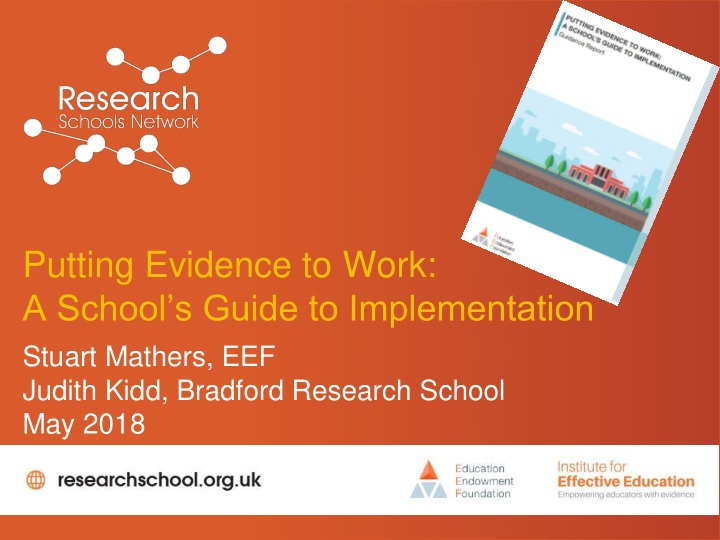



Putting Evidence to Work: A School’s Guide to Implementation Stuart Mathers, EEF Judith Kidd, Bradford Research School May 2018
Session outline • Introduction to the evidence around implementation • Implementation in your schools • Implementation activities
Education Endowment Foundation • The EEF is an independent grant-making charity dedicated to breaking the link between family income and educational achievement. o Founded in 2011 by the Sutton Trust, in partnership with Impetus PEF. o Established with a £125m grant from the UK Department for Education. o Focuses on children aged 3-18. • In 2014 the EEF’s focus was extended to the early years. • Since 2011 the EEF has awarded £90 million to fund 153 projects working with over 10,000 schools across England.
Why use research and evidence? Helps teachers and leaders make more informed decisions about what to do (and what to stop doing!) to improve outcomes ( “best bets” ). Research evidence supplements expertise it does not supplant it.
Evidence-informed improvement cycle
Implementation Matters In the US, healthcare workers failure to wash hands effectively was major cause of death – $billions • Trial showed 66% reduction in infection rates, ~1500 lives in 18 months.
What’s your experience? Think of a project you were involved with, that despite the best intentions, lost momentum and faded away. Vision> Shared vision> Shared practice
The Evidence…
• Allow enough time, particularly in the preparation stage; prioritise appropriately. • Do fewer things better – stop approaches that aren’t working.
• Specify a tight area of focus for improvement Be specific Pupil-level information, data on staffing, resources, stakeholder perceptions Don’t start with a solution looking for a problem! • Identify possible approaches to implement. What has worked in similar contexts? Guidance Reports, Teaching and Learning Toolkit, Evidence for Impact • Examine fit and feasibility. Will it work for us?
a. Create a clear, logical, and well-specified plan. Describe: • the issue you want to address; • the approach you want to implement – active ingredients of the intervention ; • the changes you hope to see – implementation outcomes (e.g. fidelity, reach) • who will be affected by these changes and how; • the implementation activities planned to contribute toward this change - multiple • the resources required; and • any external factors that could influence results.
Logic model
Use a range of activities. Think about • sequencing • timing • working at different levels • using existing capacity Precision Rhythm Alignment
b. Thoroughly assess the degree to which the school is ready to implement Implementation readiness = motivation + general capacity + innovation-specific capacity Prepare practically Revise plan.. or rethink decision
c. Practically prepare for delivering the approach • Create a shared understanding of the implementation process • Introduce new skills, knowledge, and strategies with explicit up-front training. Understand the theory and rationale behind a new approach; Introduce skills, knowledge, and strategies • Prepare the infrastructure – governance, equipment, administrative support (all notable by their absence).
• Support staff and solve problems using a flexible leadership approach Expect push-back - manage expectations and encourage ‘buy - in’ • Reinforce initial training with follow-on support within the school Coaches/mentors - observation, feedback, modelling, encouragement Conceptual understanding classroom practice • Use implementation data to drive faithful adoption and intelligent adaption People like the latter more than the former!
Introduce new skills, knowledge and strategies with explicit up-front training (p29) Follow-on support (coaching/mentoring), within the school setting, helps apply the skills and knowledge that are introduced in initial training (p33) Complement expert coaching and mentoring with structured peer-to-peer collaboration. Implement coaching plans in a structured manner. Ensure there is a rhythm, duration and alignment to professional development activities (don’t overwater!)
• Plan for sustaining and scaling an innovation from the outset. • Treat scale-up as a new implementation process. • Continuously acknowledge, support, and reward good implementation practices.
The evidence and your school Speed Card sort: 1. Divide the cards into two lists: what makes good implementation and what doesn’t… ( 5 mins ) 2. Now thinking about your school and plans for next year, which do you think you need to bear in mind most/ work on? ( 5 mins )
Active Ingredients the essential principles and practices within a programme that relate to the underlying mechanism of change. 1. Think about one thing in school you are trying to change. Can you describe the active ingredients of the programme/intervention you are using? (5mins alone) 2. Challenge each other. (5mins in pairs) Are you sure these are active ingredients and not implementation activities? Are these essential? Do you know where to be ‘tight’ and where to be ‘loose’?
What will be expected, supported & rewarded? 1. What is being expected ? Examples: time commitments, staffing commitments (inc. leadership), training commitments, follow-on support activities, intersession activities (e.g. planning), capturing & sharing data 2. What is being supported ? Examples: clarity on active ingredients/core components, training & coaching/mentoring provision, tools and resources, suggested implementation outcomes. 3. What is being rewarded ? Examples: career progression opportunities, alignment with OfSTED Fill in the template for your change
How does the evidence around effective implementation shape your planning for next year? Does it affect your approach to professional development?
Contact details Bradford Research School: Email:mark.miller.bradford@researchschool.org.uk Follow: @BradResearchSch Huntington Reseach School: Email: huntresearchsch@gmail.com Follow: @HuntResearchSch NYC Research School Email:headteacher@settrington.n-yorks.sch.uk Follow: @NYCResearchSch Or: stuart.mathers@eefoundation.org.uk
Recommend
More recommend